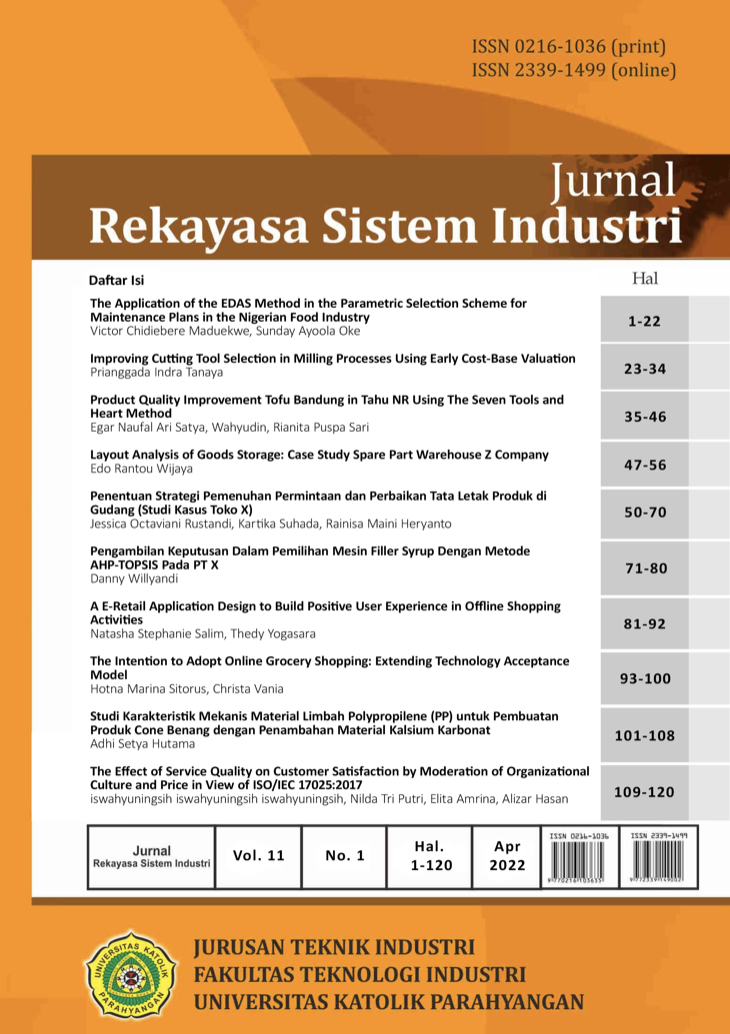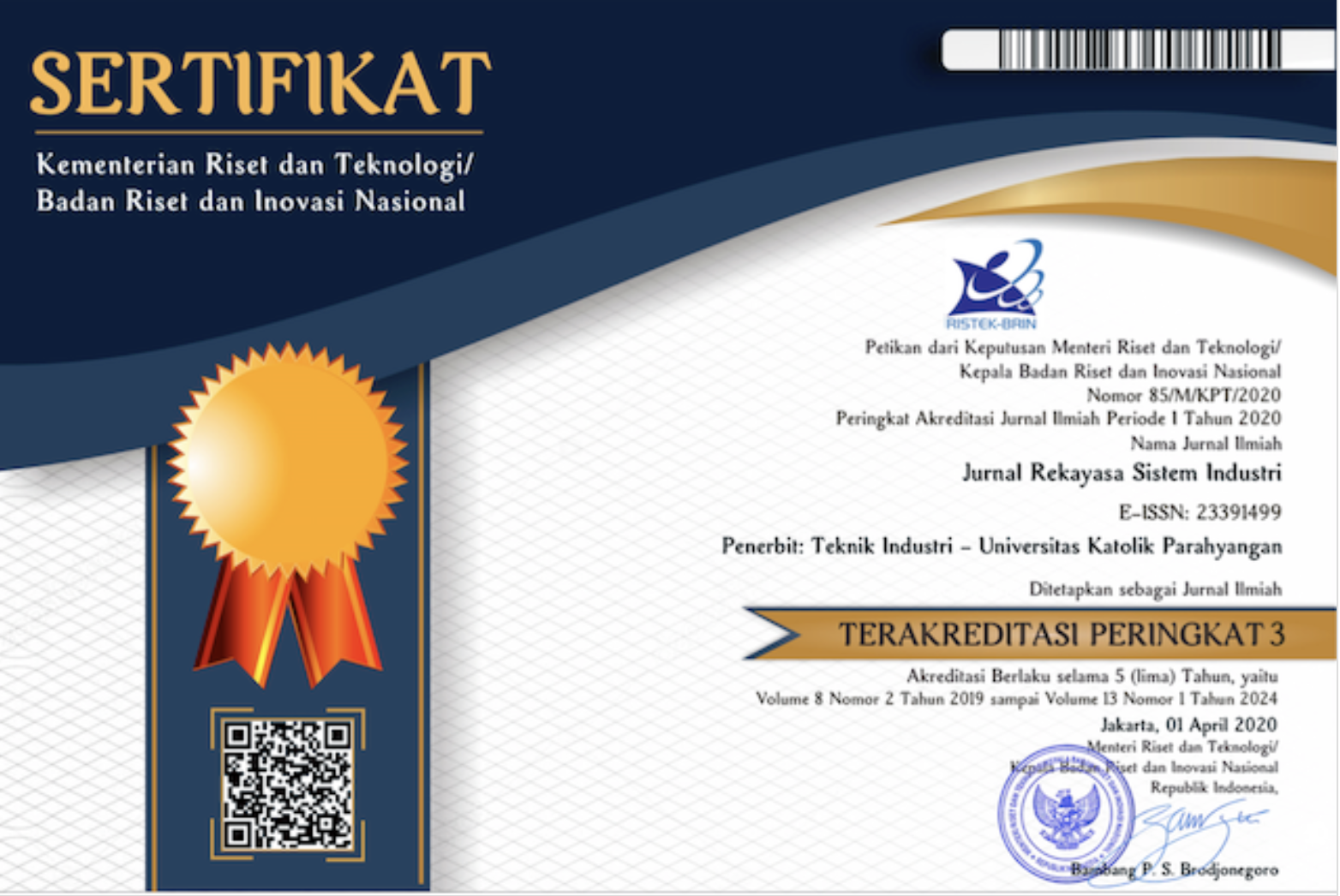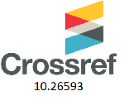Improving Cutting Tool Selection in Milling Processes Using Early Cost-Base Valuation
DOI:
https://doi.org/10.26593/jrsi.v11i1.5023.23-34Kata Kunci:
cutting tool selection, milling optimization, cutting tool valuation, cost estimation, cutting tool deflectionAbstrak
Selecting cutting tools for a milling process is crucial to determine the optimal cut. Minimizing milling process-cost is one of the most common optimization objectives, and thus it determines the best cutting tool to be used. However, the chosen cutting tool might not bring the optimal result based on the tool’s cost. Therefore, a valuation method based on the process and cutting-tool costs results were developed and analyzed to improve the cutting tool selection process. A specific rough-milling operation was entered to the quick cost-estimation and optimization application, and several cutting-tools were compared based on the process-cost by each tool. Using a weight-based analysis on both process-cost and tool-cost changes the cutting-tool options' initial rankings. This study showed that using different weight ratios altered the order of the most suitable cutting tools. Another finding revealed in this study is how deflection constraint affected the rank of cutting tool selection. Thus, knowing the proper limit of deflection is crucial to validate the cutting tool selection outcome.
Referensi
Abbas, A. T., Pimenov, D. Y., Erdakov, I. N., Mikolajczyk, T., Soliman, M. S., & El Rayes, M. M. (2019). Optimization of cutting conditions using artificial neural networks and the Edgeworth-Pareto method for CNC face-milling operations on high-strength grade-H steel. International Journal of Advanced Manufacturing Technology, 105(5–6), 2151–2165. https://doi.org/10.1007/s00170-019-04327-4
Atia, M., Khalil, J., & Mokhtar, M. (2017). A Cost Estimation Model for Machining Operations; an Ann Parametric Approach. Journal of Al-Azhar University Engineering Sector, 12(44), 878–885. https://doi.org/10.21608/auej.2017.19195
Badiger, P. V., Desai, V., Ramesh, M. R., & Raveendra, K. (2018). Optimization of machining parameters in turning process of mdn431 using ti-multilayer coated tool. International Journal of Modern Manufacturing Technologies, 10(1), 7–12.
Blum, C., Pinacho, P., López-Ibáñez, M., & Lozano, J. A. (2016). Construct, Merge, Solve & Adapt A new general algorithm for combinatorial optimization. Computers and Operations Research, 68, 75–88. https://doi.org/10.1016/j.cor.2015.10.014
Chen, X., Li, C., Tang, Y., Li, L., Du, Y., & Li, L. (2019). Integrated optimization of cutting tool and cutting parameters in face milling for minimizing energy footprint and production time. Energy, 175, 1021–1037. https://doi.org/10.1016/j.energy.2019.02.157
Conradie, P., Dimitrov, D., & Oosthuizen, G. (2016). A Cost Modelling Approach for Milling Titanium Alloys. Procedia CIRP, 46, 412–415. https://doi.org/10.1016/j.procir.2016.04.014
Dai, H., Khalil, E. B., Zhang, Y., Dilkina, B., & Song, L. (2017). Learning combinatorial optimization algorithms over graphs. Advances in Neural Information Processing Systems, 2017-Decem(Nips), 6349–6359.
Deepan Bharathi Kannan, T., Suresh Kumar, B., Rajesh Kannan, G., Umar, M., & Khan, M. C. (2019). Application of Genetic Algorithm Technique for Machining parameters optimization in drilling of stainless steel. Mechanics and Mechanical Engineering, 23(1), 271–276. https://doi.org/10.2478/mme-2019-0036
Duan, X., Peng, F., Yan, R., Zhu, Z., Huang, K., & Li, B. (2016). Estimation of cutter deflection based on study of cutting force and static flexibility. Journal of Manufacturing Science and Engineering, Transactions of the ASME, 138(4). https://doi.org/10.1115/1.4031678
Durieux, T., Hamadi, Y., Yu, Z., Baudry, B., & Monperrus, M. (2018). Exhaustive Exploration of the Failure-Oblivious Computing Search Space. Proceedings - 2018 IEEE 11th International Conference on Software Testing, Verification and Validation, ICST 2018, 139–149. https://doi.org/10.1109/ICST.2018.00023
Flöter, F., & Denkena, B. (2015). Analysis of Chatter Vibration and Tool Deflection in Milling with a Novel Active Machine Tool Guide. Applied Mechanics and Materials, 794, 331–338. https://doi.org/10.4028/www.scientific.net/amm.794.331
Groover, M. P. (2016). Groover's Principles of Modern Manufacturing: Materials, Processes, and Systems, SI Version (Global). Wiley.
Hazimeh, H., & Mazumder, R. (2020). Fast best subset selection: Coordinate descent and local combinatorial optimization algorithms. Operations Research, 68(5), 1517–1537. https://doi.org/https://doi.org/10.1287/opre.2019.1919 Full
Huo, D., Chen, W., Teng, X., Lin, C., & Yang, K. (2017). Modeling the influence of tool deflection on cutting force and surface generation in micro-milling. Micromachines, 8(6), 1–10. https://doi.org/10.3390/mi8060188
Ji, W., Wang, L., Haghighi, A., Givehchi, M., & Liu, X. (2018). An enriched machining feature based approach to cutting tool selection. International Journal of Computer Integrated Manufacturing, 31(1), 1–10. https://doi.org/10.1080/0951192X.2017.1356472
Kasim, M. S., Che Haron, C. H., Ghani, J. A., Hadi, M. A., Izamshah, R., Anand, T. J. S., & Mohamed, S. B. (2016). Cost evaluation on performance of a PVD coated cutting tool during end-milling of Inconel 718 under MQL conditions. Transactions of the Institute of Metal Finishing, 94(4), 175–181. https://doi.org/10.1080/00202967.2016.1179472
Lee, Y., Resiga, A., Yi, S., & Wern, C. (2020). The Optimization of Machining Parameters for Milling Operations by Using the Nelder-Mead Simplex Method. Journal of Manufacturing and Materials Processing, 4(3), 1–22. https://doi.org/10.3390/jmmp4030066
Ma, F., Zhang, H., Cao, H., & Hon, K. K. B. (2017). An energy consumption optimization strategy for CNC milling. International Journal of Advanced Manufacturing Technology, 90(5–8), 1715–1726. https://doi.org/10.1007/s00170-016-9497-0
Masood, I., Jahanzaib, M., & Haider, A. (2016). Tool wear and cost evaluation of face milling grade 5 titanium alloy for sustainable machining. Advances in Production Engineering And Management, 11(3), 239–250. https://doi.org/10.14743/apem2016.3.224
Moges, T. M., Desai, K. A., & Rao, P. V. M. (2018). Modeling of cutting force, tool deflection, and surface error in micro-milling operation. International Journal of Advanced Manufacturing Technology, 98(9–12), 2865–2881. https://doi.org/10.1007/s00170-018-2415-x
Nghiep, T. N., Sarhan, A. A. D., & Aoyama, H. (2018). Analysis of tool deflection errors in precision CNC end milling of aerospace Aluminum 6061-T6 alloy. Measurement: Journal of the International Measurement Confederation, 125, 476–495. https://doi.org/10.1016/j.measurement.2018.05.011
Ribeiro, J., Lopes, H., Queijo, L., & Figueiredo, D. (2017). Optimization of cutting parameters to minimize the surface roughness in the end milling process using the Taguchi method. Periodica Polytechnica Mechanical Engineering, 61(1), 30–35. https://doi.org/10.3311/PPme.9114
Saranya, K., John Rozario Jegaraj, J., Ramesh Kumar, K., & Venkateshwara Rao, G. (2018). Artificial Intelligence Based Selection of Optimal Cutting Tool and Process Parameters for Effective Turning and Milling Operations. Journal of The Institution of Engineers (India): Series C, 99(4), 381–392. https://doi.org/10.1007/s40032-016-0264-7
Shankar, C., Protim, D. P., & Vidyapati, K. (2018). Application of grey-fuzzy logic technique for parametric optimization of non-traditional machining processes. Grey Systems: Theory and Application, 8(1), 46–68. https://doi.org/10.1108/GS-08-2017-0028
Soori, M., Arezoo, B., & Habibi, M. (2017). Accuracy analysis of tool deflection error modelling in prediction of milled surfaces by a virtual machining system. International Journal of Computer Applications in Technology, 55(4), 308–321. https://doi.org/10.1504/IJCAT.2017.086015
Stephenson, D. A., & Agapiou, J. S. (2016). Metal Cutting Theory and Practice. CRC Press.
Sun, H., Cao, D., Zhao, Z., & Kang, X. (2018). A Hybrid Approach to Cutting Tool Remaining Useful Life Prediction Based on the Wiener Process. IEEE Transactions on Reliability, 67(3), 1294–1303. https://doi.org/10.1109/TR.2018.2831256
Wang, Y. C., Kim, D. W., Katayama, H., & Hsueh, W. C. (2018). Optimization of machining economics and energy consumption in face milling operations. International Journal of Advanced Manufacturing Technology, 99(9–12), 2093–2100. https://doi.org/10.1007/s00170-018-1848-6
Williams, J. G., & Patel, Y. (2016). Fundamentals of cutting. Interface Focus, 6(3). https://doi.org/10.1098/rsfs.2015.0108
Zhou, G., Yang, X., Zhang, C., Li, Z., & Xiao, Z. (2019). Deep learning enabled cutting tool selection for special-shaped machining features of complex products. Advances in Engineering Software, 133(28), 1–11. https://doi.org/10.1016/j.advengsoft.2019.04.007
Zhou, L., Li, J., Li, F., Xu, X., Wang, L., Wang, G., & Kong, L. (2017). An improved cutting power model of machine tools in milling process. International Journal of Advanced Manufacturing Technology, 91(5–8), 2383–2400. https://doi.org/10.1007/s00170-016-9929-x













